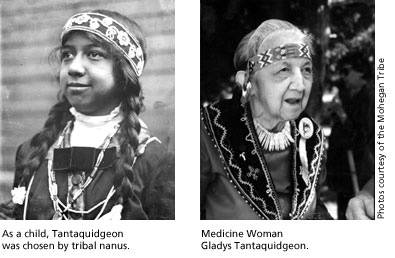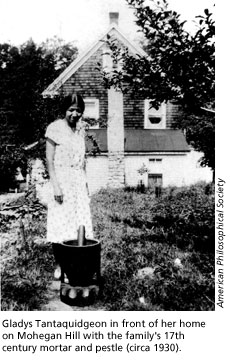
Running Against Time
Medicine Woman Preserves Mohegan
Culture

“In my earlier years,” mused Gladys Tantaquidgeon, CCT’29,
“I perhaps wasn’t aware that time was going by so rapidly, and
later I realized that many had gone. I seemed always to be working against
time.”*
The slow sweetness of youth and the fleet passage of time are not surprising subjects of meditation for an elder. Tantaquidgeon, which means “fast runner,” is 102 years old, but her relation to devouring time is far more than a story of uncommon longevity. She is the tribal medicine woman of the Mohegan Indians and holds a revered place within a long lineage of chiefs and matriarchs, a line of descent that is both traditional and innovative.
As a child on Mohegan Hill in Quinnetucket (Connecticut), she attended non-Indian elementary schools infrequently and high school not at all. “My maternal grandmother taught me most of what I learned,” she said. “I don’t recall if I had any books or not.”
Nanu Schooled
By age five, three tribal nanus, respected elder women whom she
called her “grandmothers,” had singled her out to receive the
store of traditional practices, beliefs, and lore that comprise Mohegan
culture. Women have traditionally held important positions in the tribe.
Before women in America had been granted suffrage, Nanu Emma Baker
represented the Mohegan nation before the all-white, all-male state legislature.
Women “faith keepers” have long preserved and passed down to the present day the Mohegan Trail of Life—the living memory of ceremony, herbal medicine, and stories that tell each generation who they are. “They didn’t think of that in terms of ‘Mohegan Indian cultural survival,’” Tantaquidgeon has observed. “That was just part of everyday life.” It was before she had come to realize how many had vanished and how quickly the ancient roots were withering. Now it was a matter of survival, and she was running in a race that was nearing its end. Even when she was a little girl, her people’s language was already dying on the lips of her reclusive great aunt, Jeets Bodernasha (Flying Bird), who was the last speaker of the Mohegan-Pequot dialect.
 Tantaquidgeon
knows how to make cough remedies from the inner bark on the south side
of maple trees and that a howling dog is a herald of death. She knows
that the relationship of her people, the Wolf People, with birds and animals,
lands and waters, rocks and plants is profoundly different from the experience
of most in Western society. She knows that we inhabit a vast and living
cosmos in which all things are related and that it is “good medicine”
to give thanks for all blessings. Above all, she remembers the ancient
legends and knows that time moves swiftly, despite the fact that Earth
is mounted on the back of Doyup, Grandfather Turtle.
Tantaquidgeon
knows how to make cough remedies from the inner bark on the south side
of maple trees and that a howling dog is a herald of death. She knows
that the relationship of her people, the Wolf People, with birds and animals,
lands and waters, rocks and plants is profoundly different from the experience
of most in Western society. She knows that we inhabit a vast and living
cosmos in which all things are related and that it is “good medicine”
to give thanks for all blessings. Above all, she remembers the ancient
legends and knows that time moves swiftly, despite the fact that Earth
is mounted on the back of Doyup, Grandfather Turtle.
She has often recounted the tale, handed down by Mohegan oral tradition, of the first Europeans’ arrival in great sailing vessels: “One day, we are told, an old chief, looking out across the Great Water, toward the sunrise, saw a ‘Great White Bird’ coming toward him. . . . The chief was fearful for his people. He sadly told them that many changes would take place after the coming of the white man.”
Later, in the seventeenth century, Sachem (Chief) Uncas came to understand more clearly the import of the settlers’ unprecedented and growing incursions. Holding council with the elders at the traditional place on Cochegun Rock, he decided to “break arrows,” to make friends, with the “pale strangers.” The alliance brought mutual protection to the settlers and the Mohegans, but it also permitted a measure of independence, which allowed the Mohegans to hold onto their identity. Uncas has been much criticized for his strategy of accommodation and alliance. “Cochegun Rock reminded Gladys of the difficult decisions leaders make to ensure the survival of their people,” wrote Melissa Fawcett, Tantaquidgeon’s great niece and tribal historian. While most Connecticut tribes were destroyed in the wars and plagues that followed, the Mohegan nation endured.
Uncas’s Legacy
Nine generations later, Tantaquidgeon had learned from her forebear that
it is not enough to preserve the old ways. The old lessons, although vital,
must not cloud the new ones that need to be learned. Ever since contact
with the English colonists, running the race for survival has meant that
traditional teachings and practices needed to be augmented with a nimble-minded
pragmatism. So in 1919 at the age of 20, the grandmother-trained Indian
woman left Mohegan Hill and traveled to the University of Pennsylvania,
where she would learn some new lessons and hear some of the new stories
being told by the science of anthropology.
 Frank
Speck, founder of the University’s anthropology department, had been
doing fieldwork among the Mohegans since Tantaquidgeon was a child. He
recognized that she was someone extraordinary. “Hurry up and grow
up,” he told the precocious child, “and when I get married,
I’ll come back . . . and take you away.” Speck kept his promise,
finding a place for her at Penn, where she was housed with the foreign
students. She typed and filed for the department, but she also did research
with Speck, accompanied him in the field, and took classes.
Frank
Speck, founder of the University’s anthropology department, had been
doing fieldwork among the Mohegans since Tantaquidgeon was a child. He
recognized that she was someone extraordinary. “Hurry up and grow
up,” he told the precocious child, “and when I get married,
I’ll come back . . . and take you away.” Speck kept his promise,
finding a place for her at Penn, where she was housed with the foreign
students. She typed and filed for the department, but she also did research
with Speck, accompanied him in the field, and took classes.
“The University forced her to broaden her focus,” says Fawcett, by opening her to subject matter and ways of thinking she never would have encountered back on Mohegan Hill. In particular, she met Native Americans from other tribes who passed through Speck’s office. For one research project, she conducted interviews with Witaponoxwe (Walks With Daylight), a medicine man from the Lenni Lenape, a tribe from which the Wolf People had long ago split. Because of their common roots, Tantaquidgeon discovered that many of the customs and stories Witaponoxwe related were similar to what she had learned from her Mohegan nanus. The research augmented her traditional training and would later be incorporated into her book Delaware Indian Medicine Practice and Folk Belief.
In her field studies of eastern tribes, Tantaquidgeon collected many gifts. In 1931 she and her father and brother opened the Tantaquidgeon Indian Museum on Mohegan Hill, the oldest Native American-run museum. Many of the museum’s treasures were crafted and contributed by members of the Mohegan community. Other items are quite old, such as the 300 year-old beaded belt handed down to her by Flying Bird, who had received it from her own grandmother, Martha Uncas. As curator, Tantaquidgeon was able to tell museum goers the personal story, and the lore and beliefs connected to each relic, thus maintaining the oral tradition and passing down the culture to Indian and non-Indian alike.
Lessons Old and New
Speck recommended her for a position with the Bureau of Indian Affairs
in 1934. Tantaquidgeon headed west as a community worker at the Yangton
Sioux Reservation in South Dakota. As the bureau’s first Native American
specialist, her job was to help the Sioux obtain basic services: food,
shelter, clothing, medicine, and education. “Living conditions on
that reservation were pretty bad,” she recalled.
After two years trying to hold back the flood of hunger, disease, and death that poured through the fissures that had opened in a crumbling way of life, she took a job with the newly formed Federal Indian Arts and Crafts Board. In this position, she encouraged the Sioux to bolster their economic position by using inherited craft skills to restore and sell Indian art. The strategy would also make the native economy a vehicle for handing down traditional tribal skills. She taught Indian art and handiwork on several Lakota reservations, invited accomplished Native American artists to come and teach, and exhibited the art in museums across the country. Sacred ceremonies were often part of art production in Native American cultures, and Tantaquidgeon was instrumental in winning back the right to perform rituals such as the Sun Dance, which had been banned from reservations by federal authorities.
Most Native Americans with a traditional upbringing never leave home, Fawcett points out. Those who do leave for an education tend not to be steeped in the traditional teachings, and they don’t usually come home again. Medicine Woman Tantaquidgeon is unusual in both respects. In 1947, she returned to Mohegan Hill. “Remember to take the best of what the white man has to offer,” she once counseled, “and use it to still be an Indian.”
Listen and Never Forget
Now a Mohegan nanu herself, she has served on the Tribal Council,
jumped rope with nieces and nephews, written and done research, worked
on beading and finger-weaving projects, listened to problems and offered
advice over tea and crackers by the wood stove in her kitchen. Above all,
she always—always—told the old stories to anyone who visited
the Tantaquidgeon Museum. “Listen,” she’d begin “and
never forget it.”
Her store of tribal knowledge, along with records and correspondence she’d long hoarded in Tupperware containers under her bed, provided critical information for the tribe’s recognition as a sovereign Indian nation. That status gave the tribe access to federal funds for building the Mohegan Sun casino, whose profits are the source of scholarships and other social services. The casino has been so successful that the federal monies were returned so the government could put them toward helping other tribes. The Mohegans recently made a gift of $10 million to the Smithsonian Institute toward building the National Museum of the American Indian.
“Much credit for tribal survival is due to Uncas’s decisions,” Fawcett explains, “and those of the chiefs and tribespeople after him who followed his example.” Tantaquidgeon’s fast running is perhaps no match for fleet-footed time, but it has ensured that no member of the tribe has, thus far, been the last of the Mohegans. “She’s a walking legend,” her great niece continues. “She instilled in us a sense of who we are. We wouldn’t have survived the last century without her.”
A statue of the twenty-first-century medicine woman, carved in sacred basswood, now watches over the reservation. Somewhere on Mohegan Hill, a dog is howling. “Tribal members refer to [the sculpture] simply as Gladys,” Fawcett comments, “a name that, like Uncas’s, commands the respect of all Mohegans past, present, and future.”
*Gladys Tantaquidgeon no longer appears in public or conducts interviews. All Tantaquidgeon quotes are from her biography, Medicine Woman: The Life and Lessons of Gladys Tantaquidgeon (2000) by Melissa Jayne Fawcett.